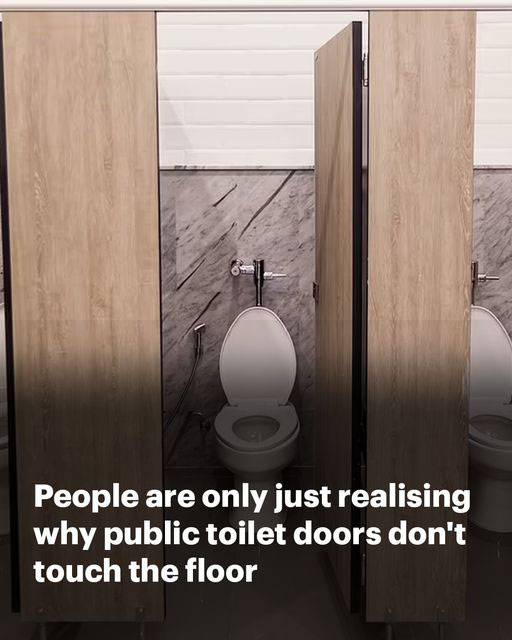Have you ever noticed how public toilet doors don’t quite reach the floor? At first glance, this design might seem strange or incomplete, but there are actually several practical reasons behind it. From improving safety and hygiene to reducing costs and promoting efficiency, the gaps under public restroom doors are an intentional and thoughtful feature of restroom design. Let’s explore why these doors are designed this way and how they address common challenges in public restroom management.

1. Emergency Access
One of the most important reasons for the gap is to allow quick access in emergencies. If someone inside a stall is in distress or requires immediate assistance, the open space at the bottom of the door makes it easier for others to assess the situation and provide help. As TikTok user MattypStories explains, “If there’s ever an emergency, it would be pretty easy to see what happened and get the person some help.” This design ensures that emergencies can be addressed quickly without the need for forceful entry or delay.
2. Easier Cleaning
Cleaning public restrooms is a daunting task, especially in high-traffic areas, and the gap under the doors significantly simplifies the process. Custodians can easily slide mops, brooms, or pressure washers underneath the doors to reach every corner of the stall. This efficient cleaning method ensures that the facilities remain sanitary for all users. A toilet fitting company, ToiletPartitions, highlights this benefit, stating, “The open floor plan makes it easy for janitors to clean the stalls. A mop or pressure washer can easily fit into the stalls and between the doors.”
3. Cost-Effective Design
Budget is a significant factor in public restroom design, and partial-height doors are far more economical than full-length ones. Shorter doors use less material, making them cheaper to manufacture and install. Additionally, they reduce maintenance costs over time. TikTok user MattypStories points out, “It’s a lot cheaper to buy a door that has part of it cut off than the full door itself.” By choosing this design, facilities can manage costs while still providing functional and effective stalls.
4. Improved Air Circulation
Good ventilation is critical in public restrooms to minimize odors and maintain a pleasant environment. The gaps at the bottom of the doors promote better airflow, allowing unpleasant smells to dissipate more quickly. As WC Portables explains, “The gap between the door and the floor provides a quick escape of the foul smell that was generated by previous users.” This simple feature improves the overall atmosphere of public restrooms, making them more tolerable for users.
5. Deters Misbehavior
Unfortunately, public restrooms can sometimes attract inappropriate behavior, and shorter doors provide less privacy, discouraging such activities. When there’s a visible gap, it becomes easier for others to spot unusual behavior and intervene if necessary. According to WC Portables, “Shorter doors help ensure the toilet queue flows and people refrain from exhibiting poor behavior due to the embarrassment of being spotted.”
6. Quick Exit in Case of Emergencies
If a stall door lock jams or malfunctions, the gap provides a way for individuals to escape without panicking. Crawling under the door may not be ideal, but it’s a practical solution that avoids unnecessary stress or the need to break the door. “If the door gets stuck, you can crawl out,” one user noted, highlighting the importance of this design in emergencies.
7. Easy Occupancy Check
The awkwardness of knocking on a stall door to check if it’s occupied is something most people would rather avoid. The gap provides a clear visual cue, allowing users to see if a stall is vacant or in use. ToiletPartitions explains, “Rather than having to knock on the door to see if a public bathroom is available, a gap at the end of the stall helps to determine if the stall is vacant or not.” This small detail saves time and prevents unnecessary interruptions.
8. Faster Turnover
The lack of complete privacy that comes with shorter doors often encourages users to finish their business more quickly. Knowing that others might hear or see through the gaps can make people more conscious of their time in the stall, leading to faster turnover. WC Portables adds, “When individuals sense others can listen to their business that easily, they are prone to wrap up quickly.” This design ultimately reduces wait times in busy restrooms.
9. Convenient Access to Supplies
Running out of toilet paper in a public stall is a frustrating situation, but the gap allows for easy communication and assistance. Whether it’s passing a roll of toilet paper or calling for help, the open space at the bottom of the door facilitates interaction between users. “You can ask someone for toilet paper if you don’t have it,” another user pointed out.
Conclusion
While the gaps under public toilet doors might seem unconventional, they serve a variety of important purposes. From ensuring safety and promoting hygiene to reducing costs and improving efficiency, these features are a practical and well-thought-out aspect of restroom design. The next time you find yourself in a public restroom, you can appreciate the clever logic behind this seemingly simple feature and how it enhances the overall experience for users.





